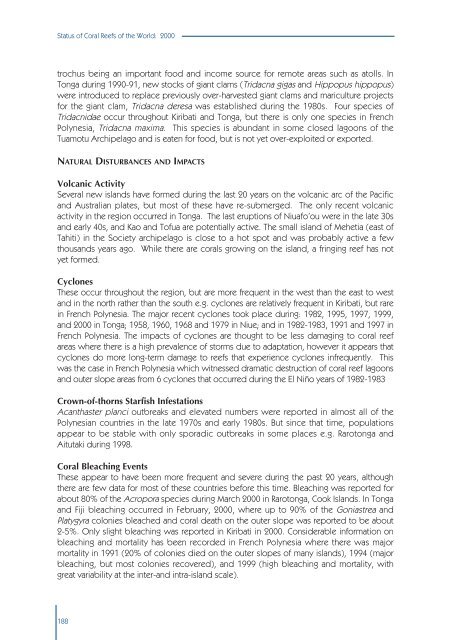Status of Coral Reefs of the World 2000
Status of Coral Reefs of the World 2000.pdf
Status of Coral Reefs of the World 2000.pdf
- No tags were found...
Create successful ePaper yourself
Turn your PDF publications into a flip-book with our unique Google optimized e-Paper software.
<strong>Status</strong> <strong>of</strong> <strong>Coral</strong> <strong>Reefs</strong> <strong>of</strong> <strong>the</strong> <strong>World</strong>: <strong>2000</strong><br />
trochus being an important food and income source for remote areas such as atolls. In<br />
Tonga during 1990-91, new stocks <strong>of</strong> giant clams (Tridacna gigas and Hippopus hippopus)<br />
were introduced to replace previously over-harvested giant clams and mariculture projects<br />
for <strong>the</strong> giant clam, Tridacna deresa was established during <strong>the</strong> 1980s. Four species <strong>of</strong><br />
Tridacnidae occur throughout Kiribati and Tonga, but <strong>the</strong>re is only one species in French<br />
Polynesia, Tridacna maxima. This species is abundant in some closed lagoons <strong>of</strong> <strong>the</strong><br />
Tuamotu Archipelago and is eaten for food, but is not yet over-exploited or exported.<br />
NATURAL DISTURBANCES AND IMPACTS<br />
Volcanic Activity<br />
Several new islands have formed during <strong>the</strong> last 20 years on <strong>the</strong> volcanic arc <strong>of</strong> <strong>the</strong> Pacific<br />
and Australian plates, but most <strong>of</strong> <strong>the</strong>se have re-submerged. The only recent volcanic<br />
activity in <strong>the</strong> region occurred in Tonga. The last eruptions <strong>of</strong> Niuafo’ou were in <strong>the</strong> late 30s<br />
and early 40s, and Kao and T<strong>of</strong>ua are potentially active. The small island <strong>of</strong> Mehetia (east <strong>of</strong><br />
Tahiti) in <strong>the</strong> Society archipelago is close to a hot spot and was probably active a few<br />
thousands years ago. While <strong>the</strong>re are corals growing on <strong>the</strong> island, a fringing reef has not<br />
yet formed.<br />
Cyclones<br />
These occur throughout <strong>the</strong> region, but are more frequent in <strong>the</strong> west than <strong>the</strong> east to west<br />
and in <strong>the</strong> north ra<strong>the</strong>r than <strong>the</strong> south e.g. cyclones are relatively frequent in Kiribati, but rare<br />
in French Polynesia. The major recent cyclones took place during: 1982, 1995, 1997, 1999,<br />
and <strong>2000</strong> in Tonga; 1958, 1960, 1968 and 1979 in Niue; and in 1982-1983, 1991 and 1997 in<br />
French Polynesia. The impacts <strong>of</strong> cyclones are thought to be less damaging to coral reef<br />
areas where <strong>the</strong>re is a high prevalence <strong>of</strong> storms due to adaptation, however it appears that<br />
cyclones do more long-term damage to reefs that experience cyclones infrequently. This<br />
was <strong>the</strong> case in French Polynesia which witnessed dramatic destruction <strong>of</strong> coral reef lagoons<br />
and outer slope areas from 6 cyclones that occurred during <strong>the</strong> El Niño years <strong>of</strong> 1982-1983<br />
Crown-<strong>of</strong>-thorns Starfish Infestations<br />
Acanthaster planci outbreaks and elevated numbers were reported in almost all <strong>of</strong> <strong>the</strong><br />
Polynesian countries in <strong>the</strong> late 1970s and early 1980s. But since that time, populations<br />
appear to be stable with only sporadic outbreaks in some places e.g. Rarotonga and<br />
Aitutaki during 1998.<br />
<strong>Coral</strong> Bleaching Events<br />
These appear to have been more frequent and severe during <strong>the</strong> past 20 years, although<br />
<strong>the</strong>re are few data for most <strong>of</strong> <strong>the</strong>se countries before this time. Bleaching was reported for<br />
about 80% <strong>of</strong> <strong>the</strong> Acropora species during March <strong>2000</strong> in Rarotonga, Cook Islands. In Tonga<br />
and Fiji bleaching occurred in February, <strong>2000</strong>, where up to 90% <strong>of</strong> <strong>the</strong> Goniastrea and<br />
Platygyra colonies bleached and coral death on <strong>the</strong> outer slope was reported to be about<br />
2-5%. Only slight bleaching was reported in Kiribati in <strong>2000</strong>. Considerable information on<br />
bleaching and mortality has been recorded in French Polynesia where <strong>the</strong>re was major<br />
mortality in 1991 (20% <strong>of</strong> colonies died on <strong>the</strong> outer slopes <strong>of</strong> many islands), 1994 (major<br />
bleaching, but most colonies recovered), and 1999 (high bleaching and mortality, with<br />
great variability at <strong>the</strong> inter-and intra-island scale).<br />
188
















